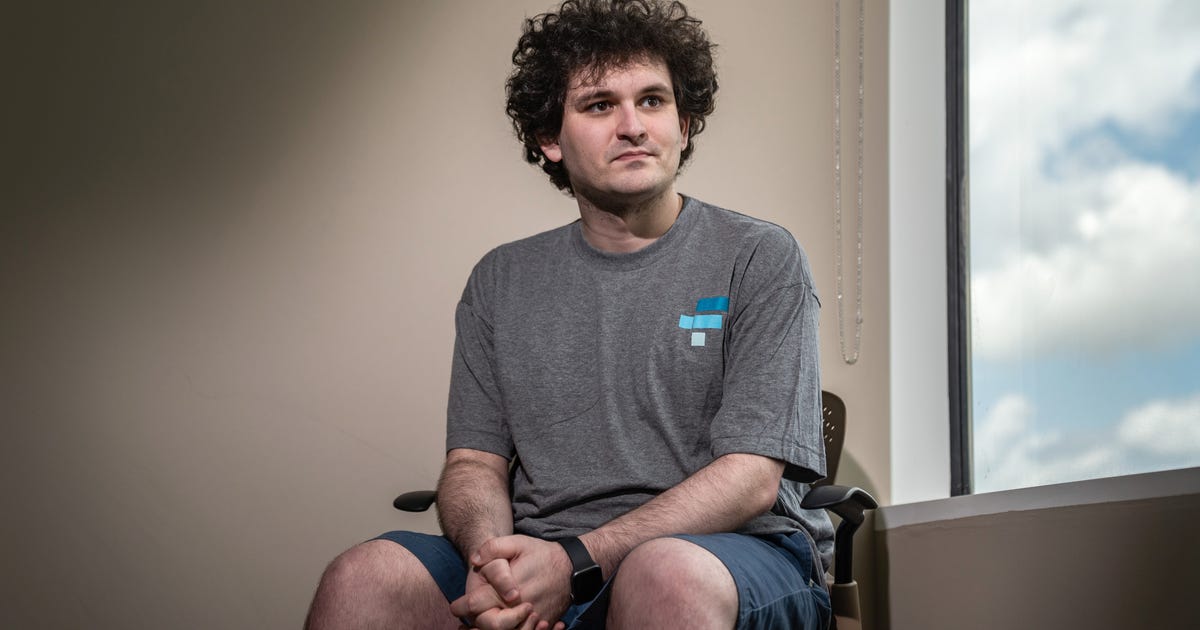
The charges continue to mount against FTX crypto exchange co-founder Sam Bankman-Fried, who’s now accused of fraud, conspiracy and violating campaign finance laws, among other infractions.
Ironically, the characteristically disheveled thirtysomething’s remarkable fall was foreseen at the apex of his FTX empire in the company’s own Super Bowl ad last year by comedian Larry David.
The multibillion-dollar, Bahamas-based exchange was among the biggest in the world, having successfully positioned itself as a safe and easy way to get into crypto. In the ad, David plays the foil who is skeptical of every great technological advance through history and naturally rejects crypto too. In the end, the message is: “Don’t be like Larry. Don’t miss out on crypto, on NFTs, on the next big thing.”
Nine months later, David’s dislikable schmuck character would get the last laugh — though David himself is being sued over the ad. In November, a series of revelations and Machiavellian chess moves by Binance, FTX’s biggest competitor, led to the collapse of FTX, the dethroning of Bankman-Fried as a leader in not only the crypto world, but also the philanthropic niche known as effective altruism.
Here’s a look at the characters and events behind a drama that’ll continue to unfold for some time.
The main players

Sam Bankman-Fried
FTX
Sam Bankman-Fried (often referred to as SBF): The son of two Stanford law professors, Bankman-Fried founded the trading firm Alameda Research in 2017, a few years after graduating from MIT. In 2019, he co-founded FTX, which rode a bull market for crypto to an $18 billion valuation in July 2021, securing investments from the likes of Softbank and Sequoia Capital. Before shifting to work on crypto full time, SBF spent time working at the philanthropical Center for Effective Altruism.
He became a leading voice of the EA movement and publicly pledged to give away a majority of his wealth. He also had an outsized presence on Capitol Hill as the second largest donor to Democratic politicians in recent years, testifying before Congress about crypto and even putting forth his own suggested draft of potential regulations for the industry just last year.
FTX: Short for “Futures Exchange,” FTX was launched off the reputation that Alameda Research had built in the industry as one of the biggest crypto traders by volume. Its stated focus was derivatives, leveraged trading and a professional approach with a goal to “move the derivatives space toward becoming institutional grade.” A notable early investor was Binance founder and CEO Changpeng Zhao, often known as “CZ.” (For more, see below.) FTX operated an international exchange out of the Bahamas. A separate entity, FTX.us, was set up in 2020 to legally service US customers. By 2021, FTX became the second largest crypto exchange behind only Binance, worth some $30 billion before it all started to unravel.
Alameda Research: The trading firm was started in 2017 by SBF and Tara Mac Aulay, who was running the Center for Effective Altruism at the time. The firm saw early success arbitraging the price of bitcoin between different markets. As it grew, it ventured into other sorts of trades and made dozens of investments into crypto projects. That includes a sizable influence in Solana, a blockchain created by an ex-Qualcomm engineer to compete with Ethereum. The relationship between Alameda and FTX had been a popular subject of speculation before beginning to leak late last year.
Quick facts: I started Alameda Research with Sam in 2017. In April 2018, I and a group of others all quit, in part due to concerns over risk management and business ethics.
— Tara Mac Aulay (@Tara_MacAulay) November 16, 2022
Caroline Ellison: The CEO of Alameda Research as of its collapse met SBF when both worked for trading firm Jane Street. Ellison joined Alameda in 2018 and became its sole CEO in August 2022. She is the daughter of two academics, like Bankman-Fried, and is said to have been in an off-and-on relationship with SBF.
Binance/CZ: Founded by Changpeng Zhao (CZ), Binance is the world’s largest cryptocurrency exchange by a significant amount following the collapse of FTX. CZ was an early investor in FTX, but the relationship reportedly soon soured, and his stake in the company was sold back in 2021. CZ’s familiarity with FTX and SBF played a pivotal role in triggering the current debacle.
Bankman-Fried, Ellison and representatives from Binance, FTX, FTX.us and Alameda didn’t respond to requests for comment. The communications firm that represented FTX, FTX.us and Alameda prior to their demise responded that it’s no longer engaged with the companies. Other contacts for FTX and FTX.us didn’t respond.
The timeline
May to July 2022: A series of crypto collapses, led by Terra-Luna, trigger a wave of bankruptcies among crypto lenders like Celsius, BlockFi and Voyager. FTX moves to bail out BlockFi with the option to buy the New Jersey-based company and to acquire the assets of Voyager. The investments appear to cement FTX as one of the strongest players in a tumultuous crypto universe.
Nov. 2, 2022: Leaked financials from Alameda Research show that the suspected cozy relationship between the trading firm and FTX is even closer than many thought, with a large amount of the trading firm’s assets held in the FTX native token FTT. Essentially, billions of Alameda’s value can be traced to a cryptocurrency that sister company FTX creates. Each FTT token was worth around $25.50 at the time.
Nov. 6: CZ announces Binance will sell off its substantial holdings of FTT. Fifteen minutes later, Ellison responds that Alameda would like to buy the tokens from Binance at $22 each. The price of the token begins to fluctuate almost immediately, dropping up to 10% and dipping below $22 for periods the same day.
This was the beginning of the end for FTX.
As part of Binance’s exit from FTX equity last year, Binance received roughly $2.1 billion USD equivalent in cash (BUSD and FTT). Due to recent revelations that have came to light, we have decided to liquidate any remaining FTT on our books. 1/4
— CZ 🔶 Binance (@cz_binance) November 6, 2022
Nov. 8: The price of FTT craters to less than $6, and CZ reveals that Binance has entered into a nonbinding agreement to purchase FTX completely. Crucially, the buyout depends on a due diligence check of FTX’s financials.
Nov. 9: Bloomberg reports federal agencies in the US are investigating FTX. A Binance spokesperson tells reporters: “As a result of corporate due diligence, as well as the latest news reports regarding mishandled customer funds and alleged US agency investigations, we have decided that we will not pursue the potential acquisition of FTX.com.”
Nov. 10: SBF announces that Alameda Research will shut down. Regulators in the Bahamas freeze FTX assets. The entire staff of the Effective Altruism-inspired FTX Future Fund, which had committed $160 million in funds to various projects, resigns.
Nov. 11: FTX, FTX.us, Alameda and dozens of subsidiaries file for bankruptcy in the US. SBF resigns as CEO and is replaced by John J. Ray III, who famously oversaw the liquidation of Enron. Late in the day, FTX is hacked and over $300 million is moved off the exchange. FTX advises users to delete its mobile app. SBF later blames an “ex-employee, or malware on an ex-employee’s computer” for the theft.
Nov. 13: Reuters reports that at least $1 billion in FTX customer funds can’t be accounted for.
Nov. 15: A class action lawsuit is filed in Florida against FTX and a number of celebrity “brand ambassadors,” including Larry David, Tom Brady, Gisele Bundchen, Kevin O’Leary, Naomi Osaka, Shaquille O’Neal and Stephen Curry, alleging deception of consumers.
Nov. 16: The US House Financial Services and Senate Banking committees announce they will hold hearings into the implosion of FTX in December. SBF tells Vox via Twitter DMs he regrets filing for bankruptcy and still hopes to raise $8 billion to make all FTX customers whole.
Nov. 17: In a bankruptcy court filing, new FTX CEO Ray says: “Never in my career have I seen such a complete failure of corporate controls and such a complete absence of trustworthy financial information as occurred here. From compromised systems integrity and faulty regulatory oversight abroad, to the concentration of control in the hands of a very small group of inexperienced, unsophisticated and potentially compromised individuals, this situation is unprecedented.”
Nov. 21: A deepfake video emerges on Twitter under a fake SBF account with a blue check mark that appears to show Bankman-Fried telling affected FTX users to go to a website to collect compensation through a crypto giveaway. The scheme is a textbook crypto scam, but with a convincing fake video as bait.
Over the weekend, a verified account posing as FTX founder SBF posted dozens of copies of this deepfake video offering FTX users “compensation for the loss” in a phishing scam designed to drain their crypto wallets pic.twitter.com/3KoAPRJsya
— Jason Koebler (@jason_koebler) November 21, 2022
Nov. 22: Specifics of the finances behind SBF’s empire begin to emerge as bankruptcy proceedings move forward. FTX representatives said they have located $1.4 billion worth of assets, but caution it may take several more weeks to establish a complete balance sheet. Meanwhile the company discloses its top 50 creditors are owed a total of $3.1 billion but doesn’t disclose names of those creditors. Tax filings also reveal that FTX and Alameda Research collectively lost $3.7 billion between 2019 and 2021, long before the current debacle, suggesting things were never going as well in the SBF empire as it may have appeared.
Nov. 30 to Dec. 11: SBF conducts an all-out media blitz, making virtual appearances live at the New York Times’ DealBook conference, on marathon Twitter Spaces, crypto podcasts and granting interviews to a wide range of outlets from major media brands to little known YouTubers. He consistently paints himself and his actions running FTX as naive at best and negligent at worst, but continues to deny allegations of deliberate wrongdoing.
“Look, I screwed up. I was the CEO of FTX, that means I was responsible,” he told The New York Times on Nov. 30. “We messed up big.”
Dec. 12: Shortly before he is expected to travel to the US to testify before Congress, SBF is arrested in the Bahamas after the US notified that country’s government that it had filed fraud charges against Bankman-Fried and would seek his extradition. SBF is denied bail and sent to the island nation’s notorious Fox Hill prison.
Dec. 21: Carolyn Ellison and FTX co-founder Gary Wang plead guilty to charges including wire fraud, securities fraud and commodities fraud. SBF continues to maintain his innocence.
Dec. 22: SBF is released from a Manhattan courthouse to the custody of his parents on $250 million bail.
Jan. 3: Bankman-Fried returns to court in New York to plead not guilty.
Feb. 23: An unsealed indictment against SBF reveals that Bankman-Fried is facing a handful of additional charges, including bank fraud and operating an unlicensed money transmitter. He now faces up to 12 counts of the various charges in a trial expected to start in October.
